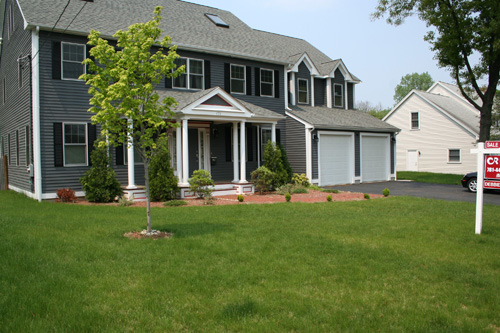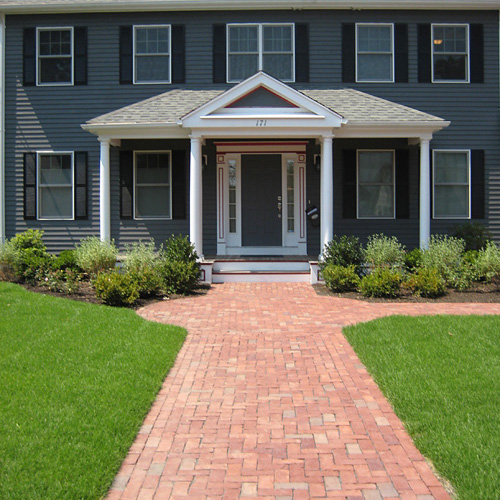- Home
- Landscape Design
- Garden Concierge
- Old House, New Garden E-zine
- Michael in the Media
- About Michael
- Contact
Walk, Don't Run
 Your front yard is your public face the world, and how it looks determines people's first impression of you and your home. That being said, how often have you and your guests run right past a boring landscape simply to get to the door?
Your front yard is your public face the world, and how it looks determines people's first impression of you and your home. That being said, how often have you and your guests run right past a boring landscape simply to get to the door?
The shot at left shows this typical three bedroom home as built. Notice how the tiny brick walk is directed to the small drive instead of to the sidewalk where there's ample street parking — a major problem whenever guests arrive as there's simply no extra space in the narrow driveway. Note too, the foundation planting installed by the builder: giant arborvitae that will soon grow to 30' tall and block all light from the windows, combined with tiny, miniature boxwood that will never rise above 1', stretched along the walk at 3' intervals. A bizarre pairing to say the least, but typical of "contractors landscape" which generally translates into "common plants poorly planted."
 Here's the reorganization: A 6' walk whose width matches that of the porch, combined with a circle which links house to both drive and street, allowing ample access for guests from either direction. Note too how much better the house appears with an appropriately scaled, flowering foundation planting that will never grow out of bounds, and provide year-round interest to both visitor and homeowner. The tall arborvitae from the previous photo have been relocated to the property line where their size and mass will give added privacy to the yard, and the other small plantings reused in a backyard ornamental planting.
Here's the reorganization: A 6' walk whose width matches that of the porch, combined with a circle which links house to both drive and street, allowing ample access for guests from either direction. Note too how much better the house appears with an appropriately scaled, flowering foundation planting that will never grow out of bounds, and provide year-round interest to both visitor and homeowner. The tall arborvitae from the previous photo have been relocated to the property line where their size and mass will give added privacy to the yard, and the other small plantings reused in a backyard ornamental planting.
The unfortunate fact here is that this simple design would have been so much easier — and so less expensive — if the builder had simply paid a bit more attention to the landscape during the construction phase. House buyers beware: if you're building a new home, make sure your landscape is planned out —and suitably budgeted— before the first shovel hits the ground.
Back to the contact sheet
